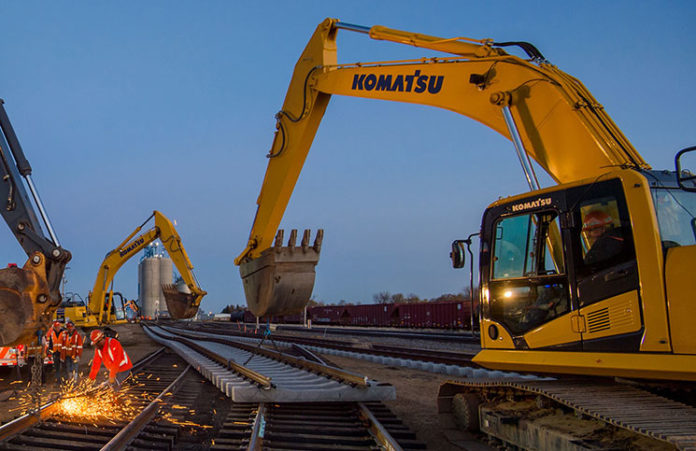When it comes to investing money in their railroad infrastructure in Washington state, Courtney Wallace, regional director of public affairs for BNSF Railway Company, said the investments are crucial as Washington state is a very important part of the BNSF network.
“Freight rail is a critical part of the economy,” Wallace said. “And we’re able to reduce carbon emissions by getting trucks off the road. When people order something online from Amazon or somewhere, it’s more than likely going to come by rail. These investments help get the products that we use every day to where they need to go.”
BNSF Railway Company recently announced that its 2018 capital expenditure program in Washington will be approximately $160 million. This year’s plan in Washington remains focused on maintenance projects in order to ensure BNSF continues to operate a safe and reliable rail network.
According to a news release from BNSF, the largest component of this year’s capital plan in the state will be for replacing and upgrading rail, rail ties and ballast, which are the main components for the tracks on which BNSF trains operate. Keeping the network infrastructure in optimal condition reduces the need for unscheduled service work that can slow down the BNSF rail network and reduce capacity.
“The foundation of our investments is always maintenance,” Wallace said. “For the general upkeep of the rail, we don’t take government money or anything for infrastructure, it’s all private investments. The bulk of that money goes into the maintenance and making sure the railway is in the best shape.”
“Freight rail helps connect local businesses with the global supply chain,” said Zak Andersen, vice president of corporate relations, according to the news release. “Whether it’s agricultural products moving to markets overseas or lumber and construction materials moving into other U.S. markets, we remain focused on operating a safe, reliable and efficient railroad for our customers and the end consumer.”
Across the state of Washington, Wallace said BNSF has already been replacing and upgrading quite a bit of rail, including some replacement work between Vancouver and Longview.
Over the past five years, BNSF has invested approximately $940 million to expand and maintain its network in Washington, according to the news release. This year, the maintenance program in Washington includes approximately 490 miles of track surfacing and/or undercutting work as well as replacement of about 40 miles of rail and close to 230,000 ties.
Along the Fallbridge Subdivision, BNSF plans to install new double-track between Washougal and Mt. Pleasant. In addition, the company will also begin to install new double-track along the Spokane Subdivision between Hauser, Idaho, and Spokane. According to the news release, two bridge replacement projects are also slated to begin this year in Home Valley and North Bonneville. The construction of a new unloading track and additional parking capacity at the Orillia Automotive Facility is also planned for 2018.
Wallace said the installation of double-track in different areas of the state is essential as it helps rail traffic flow a lot quicker and more efficiently. She said the trains are able to run simultaneously and the double-track is beneficial to Amtrak as well.
“It helps with the current traffic that we have and will also help with any increase in traffic that we might see,” Wallace said. “We saw our peak volume of rail traffic in 2006 and then we saw a pretty steep decline when the recession came through. But now, as the population continues to grow and the economy continues to improve, we’re seeing more freight traffic coming through. When the economy is up, rail traffic grows. If we build now, it helps with current and future traffic volumes.”
According to the news release, the 2018 planned capital investments in the state are part of BNSF’s $3.3 billion network-wide capital expenditure program announced last month. These investments include $2.4 billion to replace and maintain core network and related assets; approximately $500 million on expansion and efficiency projects; and $100 million for continued implementation of Positive Train Control (PTC).
BNSF is the only Class 1 freight railroad to have completed the installation of PTC on all its federally mandated subdivisions and is currently running hundreds of trains daily with PTC as it tests revenue service across its mandated territory. Another element of its capital plan will be $300 million for freight cars and other equipment acquisitions.
Wallace described PTC as a system that monitors and controls train movements. The technology overlays existing train hardware and software, and, as mandated by law, is intended to prevent train-to-train collisions; derailments caused by excessive speed; unauthorized incursions by trains onto sections of track where maintenance activities are taking place; and movement of a train through a track switch left in the wrong position.
PTC uses GPS, Wi-Fi and high-band radio transmission to ensure the train does not exceed its authority; determine the location, direction and speed of the train; and take action by stopping the train if there is not a response by the train crew.
BNSF Railway is one of North America’s leading freight transportation companies. The company operates approximately 32,500 route miles of track in 28 states and also operates in three Canadian provinces. BNSF is one of the top transporters of consumer goods, grain and agricultural products, low-sulfur coal and industrial goods such as petroleum, chemicals, housing materials, food and beverages. BNSF’s shipments help feed, clothe, supply, and power American homes and businesses every day.



